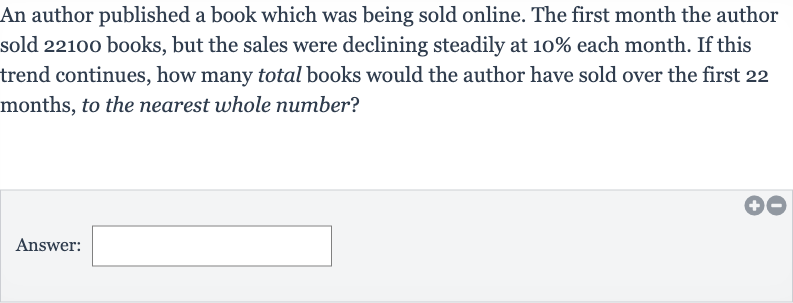AI tutor
Welcome to Bytelearn!
Let’s check out your problem:

An author published a book which was being sold online. The first month the author sold books, but the sales were declining steadily at each month. If this trend continues, how many total books would the author have sold over the first months, to the nearest whole number?Answer:
Full solution
Q. An author published a book which was being sold online. The first month the author sold books, but the sales were declining steadily at each month. If this trend continues, how many total books would the author have sold over the first months, to the nearest whole number?Answer:
- Identify initial number and decrease: Identify the initial number of books sold and the monthly percentage decrease.The author sold books in the first month and sales are declining by each month.
- Recognize geometric sequence: Recognize that the situation describes a geometric sequence where each term is (or times) of the previous term, because of the decrease.The first term is , and the common ratio is .
- Use formula for sum: Use the formula for the sum of the first terms of a geometric sequence to find the total number of books sold over the first months.The formula is , where is the sum of the first terms, is the first term, is the common ratio, and is the number of terms.
- Calculate sum of first terms: Calculate the sum of the first terms using the formula.
- Perform calculations: Perform the calculations.First, calculate .
- Calculate : Continue the calculation by subtracting this value from .
- Subtract from : Divide this result by to find the multiplier for the initial number of books sold.
- Divide by .: Multiply this value by the initial number of books sold to find the total number of books sold over the first months.
- Multiply by initial number: Round the result to the nearest whole number, as the question asks for the total number of books to the nearest whole number. rounds to .
More problems from Percent of change: word problems
QuestionGet tutor help
QuestionGet tutor help
